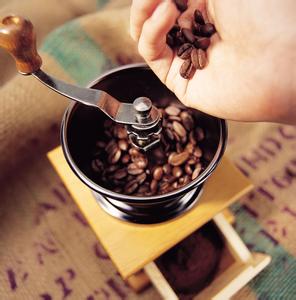Talk about the blending of coffee beans.
Blending coffee is not a random mix of coffee beans. Sometimes the blending of two kinds of boutique coffee will suppress each other's unique flavor; blending is not simply blending several kinds of boutique coffee together. Matching is like the painter adjusting and creating charming colors in the color palette, the mixer can reconcile the attractive taste according to the different characteristics of the coffee beans. It is no exaggeration to say that matching is an art. As an artist, the assembler needs not only experience and inspiration, but also scientific calculation. The emergence of works of art will not be accidental, but the outbreak of long-term accumulation.

Since it is a blending, it naturally refers to the blending of more than two kinds of raw beans, but a special example is that it can also match the same kind of coffee beans with different roasting degrees, or even the new crop and aged coffee or old crop of the same kind of coffee beans, so the type referred to in the blending is no longer a coffee variety in a narrow sense, but extends to the flavor of coffee in a broad sense. Generally use 2 to 6 kinds of coffee beans when blending, too many kinds will not be able to show the unique flavor of coffee.
Blended coffee usually does not take the 1:1 blending ratio, because this may suppress each other's unique flavor, so the blending must be primary and secondary in order to produce a better taste than a single coffee. If you want the coffee to taste complex and changeable, you can reduce the proportion of raw beans, and vice versa.
The blending of coffee depends on constant attempts, so a blending schedule should be drawn up mathematically before blending, and then the best plan should be determined through the process of blending-tasting cups.
Don't think that this is a negative and stupid approach. In fact, a good cup of coffee can only be made by the experience, inspiration and tireless attempt of the blender.
According to the difference of coffee, the mixed coffee will have different characteristics in taste.
The proportions of several flavors are listed below.
(1) mixed coffee with balanced taste
Recipes: Guatemala SHB (30%), Mexico AL (30%), Brazil (30%), Kilimanjaro AA (10%).
The top comprehensive coffee is the best combination of sour, bitter and fragrant coffee beans, which are mixed together. For example, Guatemalan coffee beans with strong sour taste, Mexican coffee beans with both sour and sweet taste, and Brazilian beans with mild bitterness. Mix these coffee beans in proportion and mix them with Kilimanjaro coffee beans with strong sour flavor. the coffee beans pointed out have a balanced taste and moderate concentration.
(2) bitterness-based mixed coffee
Recipes: Sumatra Mantenin G1 (40%), Colombia SUP (30%), Brazil (20%), Kilimanjaro AA (10%).
To produce strong-flavored coffee beans, you have to choose strong-flavored coffee beans, such as Sumatra mantenin in Indonesia, bitter and sour Colombian beans, and moderately sour Brazilian beans. And Kilimanjaro beans that are mainly sour. The coffee beans made in this way have a bitter taste and are deeply loved by coffee lovers.
(3) mixed coffee with sour taste
Recipes: Kilimanjaro AA, Mocha Plateau Hara, Brazil, Kona NO.1, Hawaii.
To make sour coffee beans, it is necessary to use Kilimanjaro coffee beans, on this basis, with Ethiopia's soft taste of mocha? Plateau Hara as well as Brazilian beans and moderately acidity Kona, Hawaii, so that you can make a sour coffee mix.
(4) aroma-based comprehensive coffee
Ingredients: Guatemala SHB (40%), Kilimanjaro AA (30%), Harald (30%).
The aroma-based mixed coffee is a mixture of coffee beans with different characteristics to make it more fragrant. With fragrant Guatemala SHB as the main, with sour Kilimanjaro beans and natural fruit Harald, you can mix a full-bodied comprehensive coffee.
(5) American mixed coffee
Formula: Brazil (50%), Mexico AL (30%), Jamaica washed beans (20%).
For those who do not like the taste too much, do not like individual coffee, and only pursue their own taste, American mixed coffee should be the first choice. It uses moderately roasted coffee beans, mainly Brazilian beans with a balanced sour and bitter taste, with sweet and sour Mexican beans and Jamaican water-washed beans with flavor and bitterness, and a unique American mixed coffee was born.
(6) full-bodied and heavy mixed coffee
Recipes: Colombia SUP (50%), Brazil (30%), Java Robusta WIBI (20%).
To highlight the strong taste, it is necessary to choose Colombian beans with moderate acidity and balanced Brazilian beans, as well as rich, bitter coffee. If you want to add some sweetness, you can match some coffee beans with mild bitterness.
Coffee also blooms its own beauty on the tip of the tongue, as well as the thick culture. I hope all of us will become walkers to spread the beautiful culture. There are many cafes that have their own understanding of blended coffee, and their names are quite literary and artistic. I have drunk something like "time, memory, that day, a certain year" and so on, which is very interesting, and as long as the beans are fresh, they are all pretty good.
Important Notice :
前街咖啡 FrontStreet Coffee has moved to new addredd:
FrontStreet Coffee Address: 315,Donghua East Road,GuangZhou
Tel:020 38364473
- Prev

Oiled coffee beans and freshness
What is the relationship between the "oil" of coffee beans and the freshness? Should we buy coffee beans that have "oil" or "no oil" in appearance?
- Next

Rose summer (geisha) coffee
The species of Geisha was discovered in the Rose Summer Forest of Ethiopia in 1931 and sent to the Coffee Institute in Kenya; it was introduced to Uganda and Tanzania in 1936, in Costa Rica in 1953, and Panama was introduced in the 1970s by Francesca of Dongba Seven Farm Garden. Mr. Serraxin got the seeds from CATIE in Costa Rica and started growing Rosa Coffee because
Related
- Guji coffee producing area of Guji, Ethiopia: Humbela, Shakiso, Wulaga
- What is the most expensive variety of Qiloso in BOP multi-variety group?
- How to store the coffee beans bought home?
- Why are Yemeni coffee beans so rare now?
- Ethiopian Sidamo all Red Fruit Sun Sun Santa Vini Coffee beans
- SOE is mostly sour? What does it mean? Is it a single bean? what's the difference between it and Italian blending?
- Is Italian coffee beans suitable for making hand-brewed coffee?
- How to choose coffee beans when making cold coffee? What kind of coffee beans are suitable for making cold coffee?
- Just entered the pit to make coffee, what kind of coffee beans should be chosen?
- Can only Japan buy real Blue Mountain Coffee? What are authentic Jamaican Blue Mountain coffee beans?

